Leadership Management: Reflective Essay on Personal Approach, LB5241
VerifiedAdded on 2023/01/20
|13
|2786
|70
Report
AI Summary
This report is a reflective essay on leadership management, focusing on the application of critical leadership studies to inform a personal leadership approach. It begins with an executive summary and table of contents, followed by an introduction that differentiates between leaders and managers, emphasizing the importance of empowering human resources. The essay explores various aspects of leadership, including time management, consultation, encouraging opinions, and delegation of duties. The author discusses how they will engage in leadership studies to improve their practice, including time management, consultation, and encouraging opinions. The essay also covers practical aspects of leadership, such as appreciating performance, delegating skills, conflict resolution, and communication strategies. The author provides insights on leadership theories, methods, and assumptions. The report concludes with a reflection on the author's approach to leadership and references to the sources used.
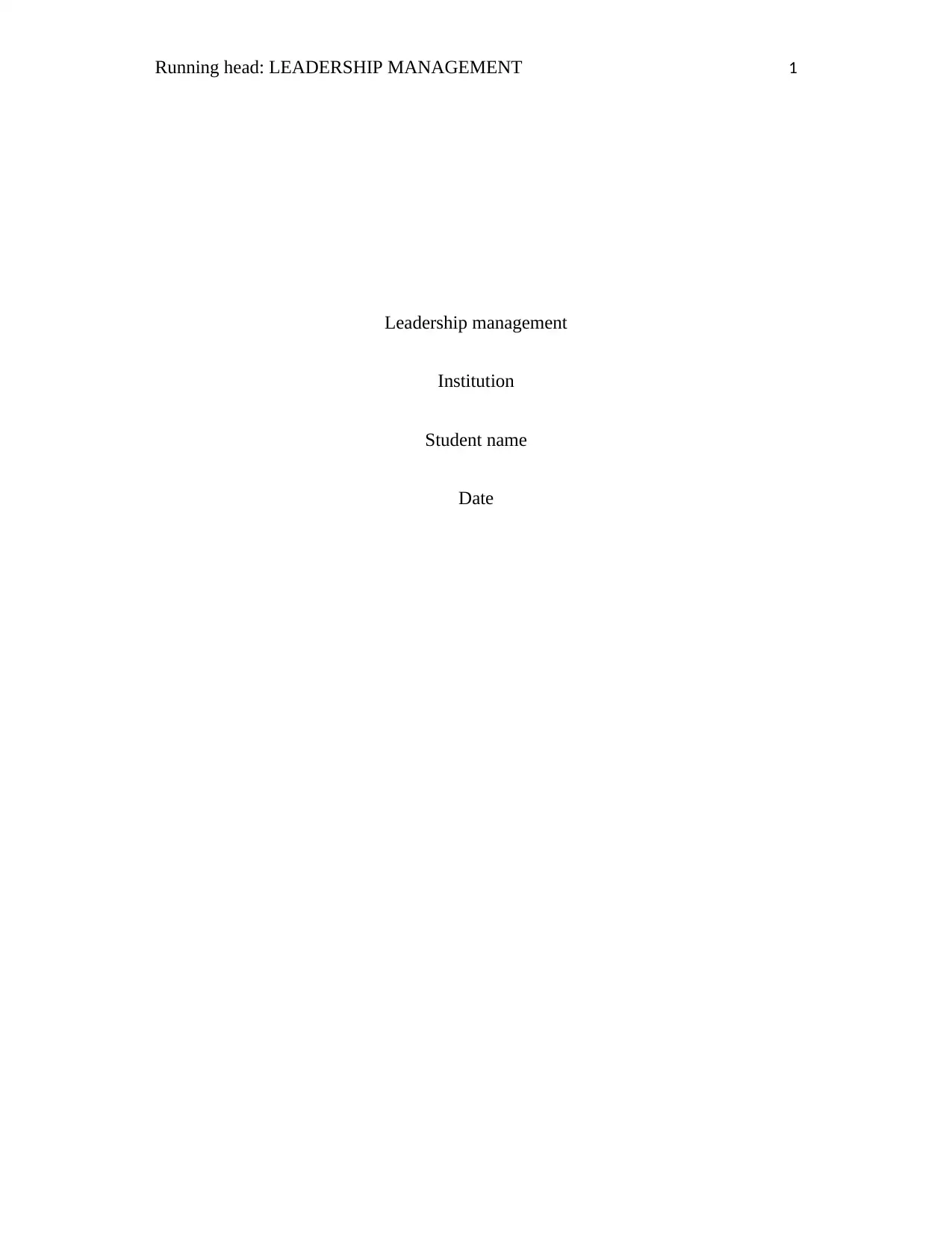
Running head: LEADERSHIP MANAGEMENT 1
Leadership management
Institution
Student name
Date
Leadership management
Institution
Student name
Date
Paraphrase This Document
Need a fresh take? Get an instant paraphrase of this document with our AI Paraphraser
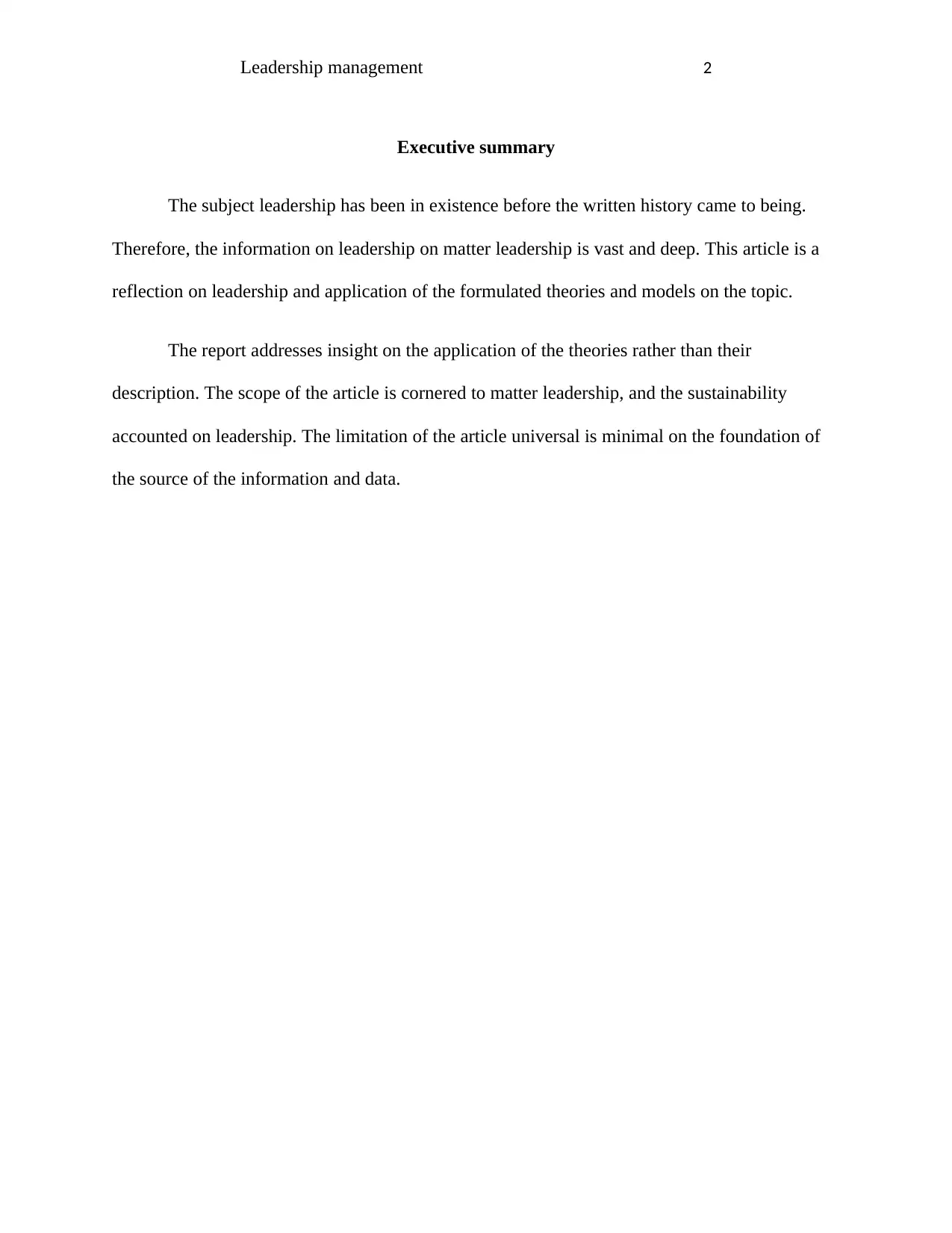
Leadership management 2
Executive summary
The subject leadership has been in existence before the written history came to being.
Therefore, the information on leadership on matter leadership is vast and deep. This article is a
reflection on leadership and application of the formulated theories and models on the topic.
The report addresses insight on the application of the theories rather than their
description. The scope of the article is cornered to matter leadership, and the sustainability
accounted on leadership. The limitation of the article universal is minimal on the foundation of
the source of the information and data.
Executive summary
The subject leadership has been in existence before the written history came to being.
Therefore, the information on leadership on matter leadership is vast and deep. This article is a
reflection on leadership and application of the formulated theories and models on the topic.
The report addresses insight on the application of the theories rather than their
description. The scope of the article is cornered to matter leadership, and the sustainability
accounted on leadership. The limitation of the article universal is minimal on the foundation of
the source of the information and data.
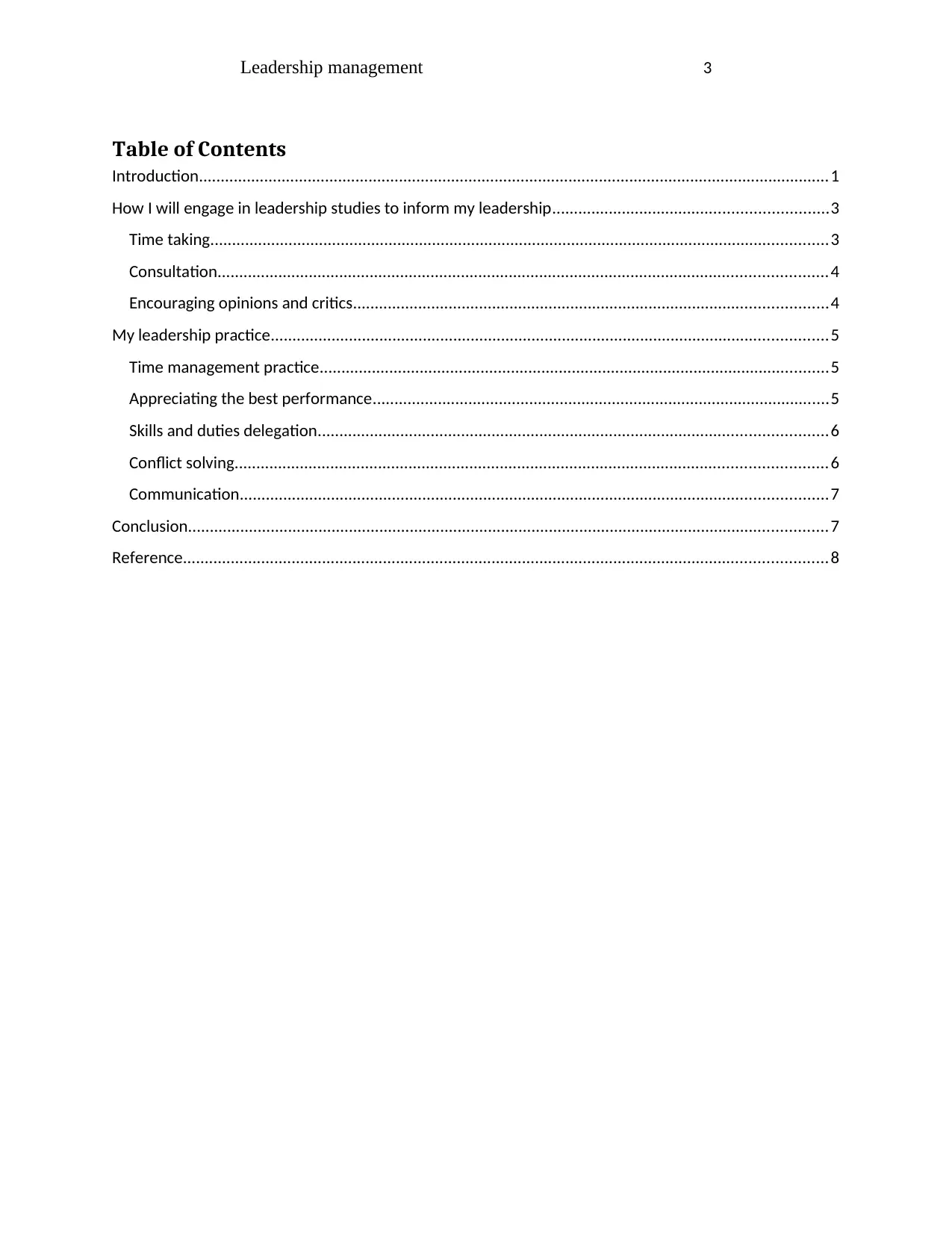
Leadership management 3
Table of Contents
Introduction.................................................................................................................................................1
How I will engage in leadership studies to inform my leadership...............................................................3
Time taking..............................................................................................................................................3
Consultation............................................................................................................................................4
Encouraging opinions and critics.............................................................................................................4
My leadership practice................................................................................................................................5
Time management practice.....................................................................................................................5
Appreciating the best performance.........................................................................................................5
Skills and duties delegation.....................................................................................................................6
Conflict solving........................................................................................................................................6
Communication.......................................................................................................................................7
Conclusion...................................................................................................................................................7
Reference....................................................................................................................................................8
Table of Contents
Introduction.................................................................................................................................................1
How I will engage in leadership studies to inform my leadership...............................................................3
Time taking..............................................................................................................................................3
Consultation............................................................................................................................................4
Encouraging opinions and critics.............................................................................................................4
My leadership practice................................................................................................................................5
Time management practice.....................................................................................................................5
Appreciating the best performance.........................................................................................................5
Skills and duties delegation.....................................................................................................................6
Conflict solving........................................................................................................................................6
Communication.......................................................................................................................................7
Conclusion...................................................................................................................................................7
Reference....................................................................................................................................................8
⊘ This is a preview!⊘
Do you want full access?
Subscribe today to unlock all pages.

Trusted by 1+ million students worldwide
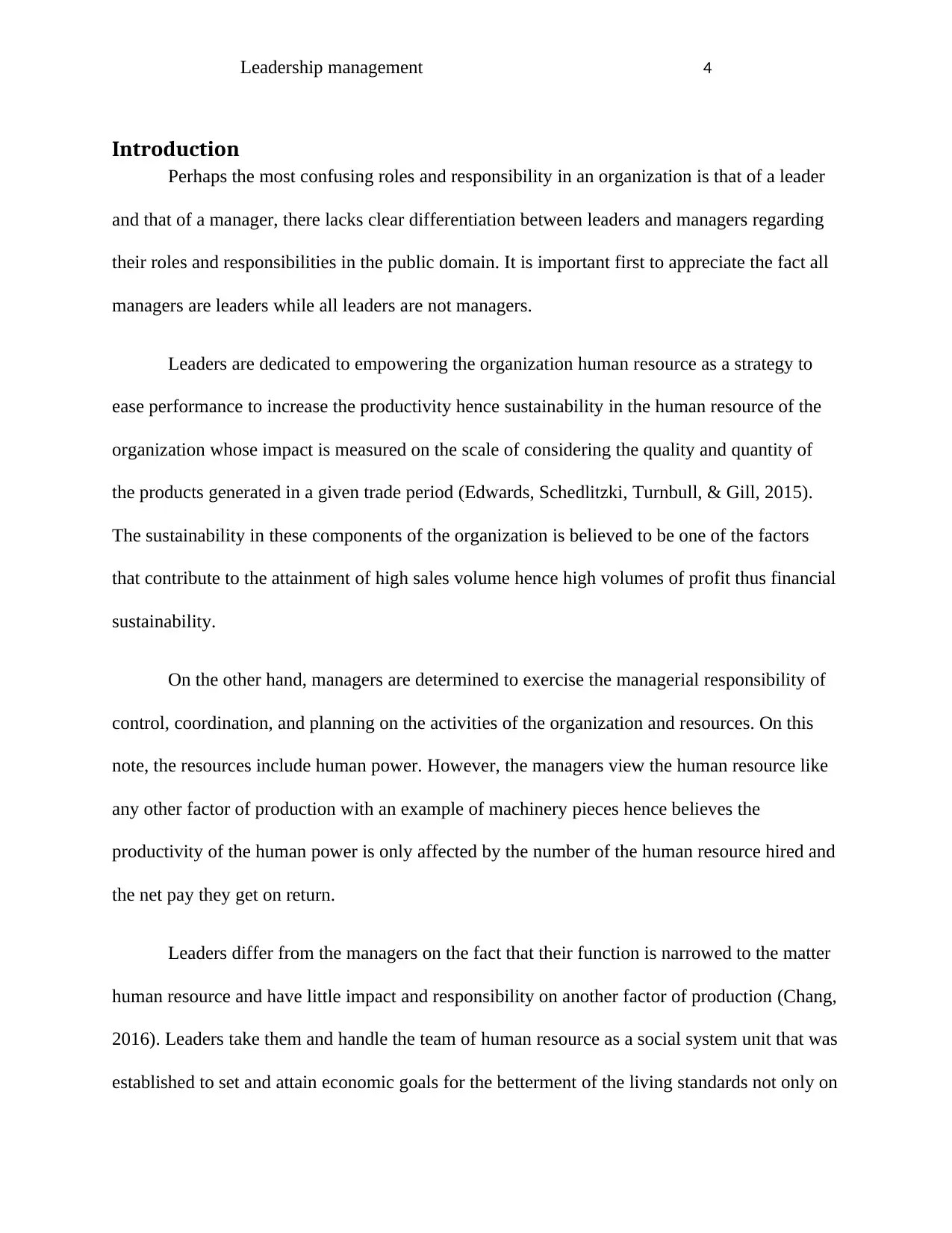
Leadership management 4
Introduction
Perhaps the most confusing roles and responsibility in an organization is that of a leader
and that of a manager, there lacks clear differentiation between leaders and managers regarding
their roles and responsibilities in the public domain. It is important first to appreciate the fact all
managers are leaders while all leaders are not managers.
Leaders are dedicated to empowering the organization human resource as a strategy to
ease performance to increase the productivity hence sustainability in the human resource of the
organization whose impact is measured on the scale of considering the quality and quantity of
the products generated in a given trade period (Edwards, Schedlitzki, Turnbull, & Gill, 2015).
The sustainability in these components of the organization is believed to be one of the factors
that contribute to the attainment of high sales volume hence high volumes of profit thus financial
sustainability.
On the other hand, managers are determined to exercise the managerial responsibility of
control, coordination, and planning on the activities of the organization and resources. On this
note, the resources include human power. However, the managers view the human resource like
any other factor of production with an example of machinery pieces hence believes the
productivity of the human power is only affected by the number of the human resource hired and
the net pay they get on return.
Leaders differ from the managers on the fact that their function is narrowed to the matter
human resource and have little impact and responsibility on another factor of production (Chang,
2016). Leaders take them and handle the team of human resource as a social system unit that was
established to set and attain economic goals for the betterment of the living standards not only on
Introduction
Perhaps the most confusing roles and responsibility in an organization is that of a leader
and that of a manager, there lacks clear differentiation between leaders and managers regarding
their roles and responsibilities in the public domain. It is important first to appreciate the fact all
managers are leaders while all leaders are not managers.
Leaders are dedicated to empowering the organization human resource as a strategy to
ease performance to increase the productivity hence sustainability in the human resource of the
organization whose impact is measured on the scale of considering the quality and quantity of
the products generated in a given trade period (Edwards, Schedlitzki, Turnbull, & Gill, 2015).
The sustainability in these components of the organization is believed to be one of the factors
that contribute to the attainment of high sales volume hence high volumes of profit thus financial
sustainability.
On the other hand, managers are determined to exercise the managerial responsibility of
control, coordination, and planning on the activities of the organization and resources. On this
note, the resources include human power. However, the managers view the human resource like
any other factor of production with an example of machinery pieces hence believes the
productivity of the human power is only affected by the number of the human resource hired and
the net pay they get on return.
Leaders differ from the managers on the fact that their function is narrowed to the matter
human resource and have little impact and responsibility on another factor of production (Chang,
2016). Leaders take them and handle the team of human resource as a social system unit that was
established to set and attain economic goals for the betterment of the living standards not only on
Paraphrase This Document
Need a fresh take? Get an instant paraphrase of this document with our AI Paraphraser
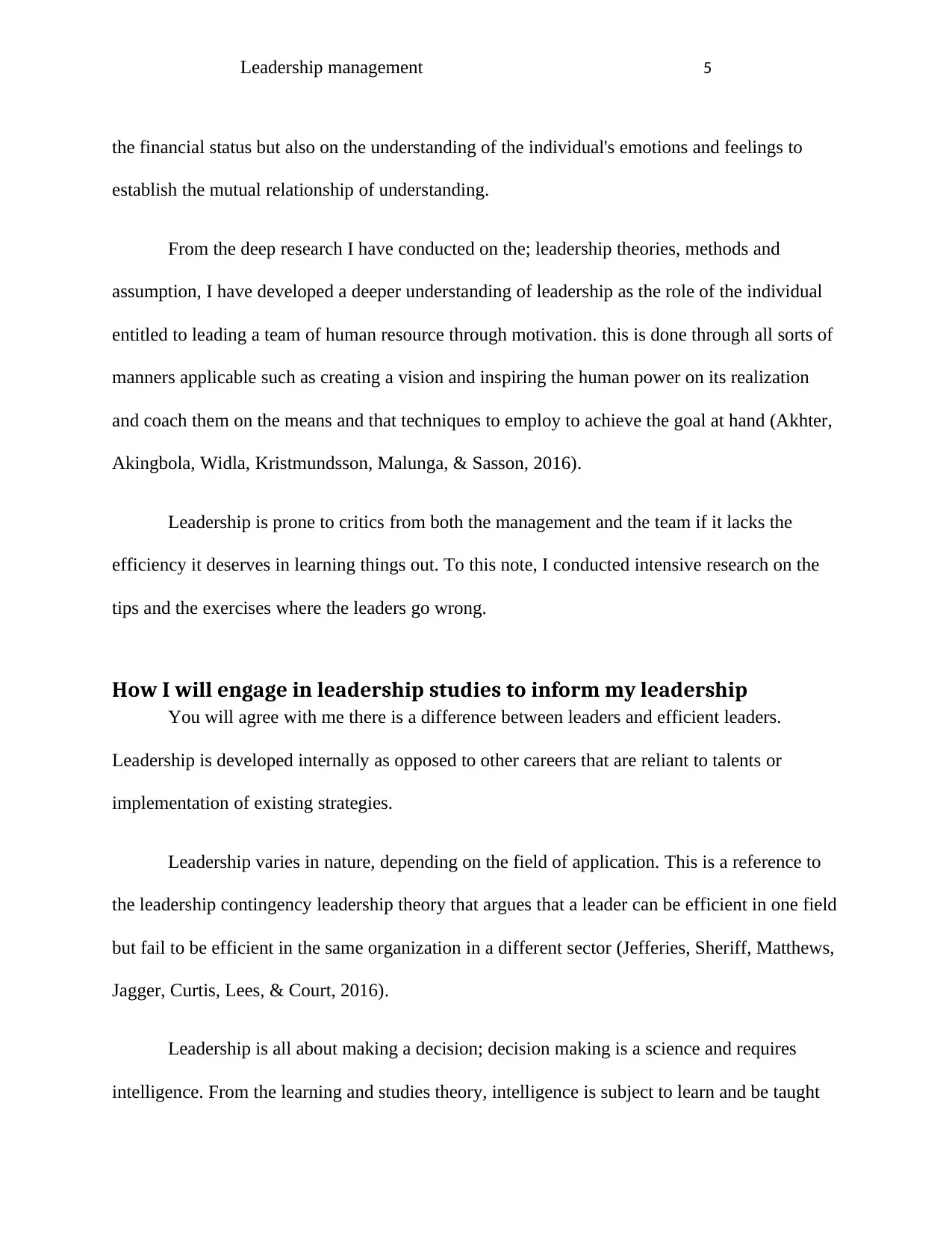
Leadership management 5
the financial status but also on the understanding of the individual's emotions and feelings to
establish the mutual relationship of understanding.
From the deep research I have conducted on the; leadership theories, methods and
assumption, I have developed a deeper understanding of leadership as the role of the individual
entitled to leading a team of human resource through motivation. this is done through all sorts of
manners applicable such as creating a vision and inspiring the human power on its realization
and coach them on the means and that techniques to employ to achieve the goal at hand (Akhter,
Akingbola, Widla, Kristmundsson, Malunga, & Sasson, 2016).
Leadership is prone to critics from both the management and the team if it lacks the
efficiency it deserves in learning things out. To this note, I conducted intensive research on the
tips and the exercises where the leaders go wrong.
How I will engage in leadership studies to inform my leadership
You will agree with me there is a difference between leaders and efficient leaders.
Leadership is developed internally as opposed to other careers that are reliant to talents or
implementation of existing strategies.
Leadership varies in nature, depending on the field of application. This is a reference to
the leadership contingency leadership theory that argues that a leader can be efficient in one field
but fail to be efficient in the same organization in a different sector (Jefferies, Sheriff, Matthews,
Jagger, Curtis, Lees, & Court, 2016).
Leadership is all about making a decision; decision making is a science and requires
intelligence. From the learning and studies theory, intelligence is subject to learn and be taught
the financial status but also on the understanding of the individual's emotions and feelings to
establish the mutual relationship of understanding.
From the deep research I have conducted on the; leadership theories, methods and
assumption, I have developed a deeper understanding of leadership as the role of the individual
entitled to leading a team of human resource through motivation. this is done through all sorts of
manners applicable such as creating a vision and inspiring the human power on its realization
and coach them on the means and that techniques to employ to achieve the goal at hand (Akhter,
Akingbola, Widla, Kristmundsson, Malunga, & Sasson, 2016).
Leadership is prone to critics from both the management and the team if it lacks the
efficiency it deserves in learning things out. To this note, I conducted intensive research on the
tips and the exercises where the leaders go wrong.
How I will engage in leadership studies to inform my leadership
You will agree with me there is a difference between leaders and efficient leaders.
Leadership is developed internally as opposed to other careers that are reliant to talents or
implementation of existing strategies.
Leadership varies in nature, depending on the field of application. This is a reference to
the leadership contingency leadership theory that argues that a leader can be efficient in one field
but fail to be efficient in the same organization in a different sector (Jefferies, Sheriff, Matthews,
Jagger, Curtis, Lees, & Court, 2016).
Leadership is all about making a decision; decision making is a science and requires
intelligence. From the learning and studies theory, intelligence is subject to learn and be taught
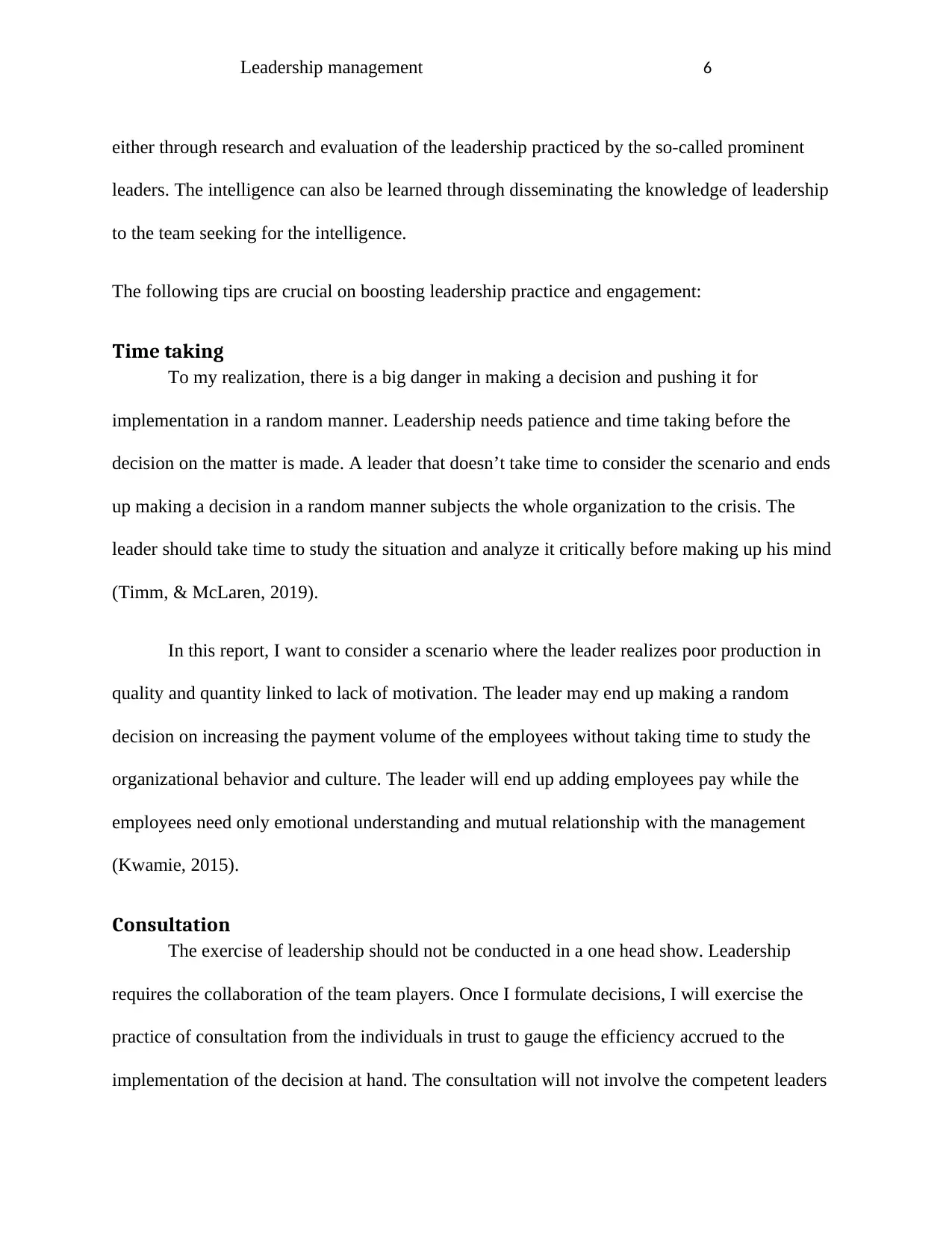
Leadership management 6
either through research and evaluation of the leadership practiced by the so-called prominent
leaders. The intelligence can also be learned through disseminating the knowledge of leadership
to the team seeking for the intelligence.
The following tips are crucial on boosting leadership practice and engagement:
Time taking
To my realization, there is a big danger in making a decision and pushing it for
implementation in a random manner. Leadership needs patience and time taking before the
decision on the matter is made. A leader that doesn’t take time to consider the scenario and ends
up making a decision in a random manner subjects the whole organization to the crisis. The
leader should take time to study the situation and analyze it critically before making up his mind
(Timm, & McLaren, 2019).
In this report, I want to consider a scenario where the leader realizes poor production in
quality and quantity linked to lack of motivation. The leader may end up making a random
decision on increasing the payment volume of the employees without taking time to study the
organizational behavior and culture. The leader will end up adding employees pay while the
employees need only emotional understanding and mutual relationship with the management
(Kwamie, 2015).
Consultation
The exercise of leadership should not be conducted in a one head show. Leadership
requires the collaboration of the team players. Once I formulate decisions, I will exercise the
practice of consultation from the individuals in trust to gauge the efficiency accrued to the
implementation of the decision at hand. The consultation will not involve the competent leaders
either through research and evaluation of the leadership practiced by the so-called prominent
leaders. The intelligence can also be learned through disseminating the knowledge of leadership
to the team seeking for the intelligence.
The following tips are crucial on boosting leadership practice and engagement:
Time taking
To my realization, there is a big danger in making a decision and pushing it for
implementation in a random manner. Leadership needs patience and time taking before the
decision on the matter is made. A leader that doesn’t take time to consider the scenario and ends
up making a decision in a random manner subjects the whole organization to the crisis. The
leader should take time to study the situation and analyze it critically before making up his mind
(Timm, & McLaren, 2019).
In this report, I want to consider a scenario where the leader realizes poor production in
quality and quantity linked to lack of motivation. The leader may end up making a random
decision on increasing the payment volume of the employees without taking time to study the
organizational behavior and culture. The leader will end up adding employees pay while the
employees need only emotional understanding and mutual relationship with the management
(Kwamie, 2015).
Consultation
The exercise of leadership should not be conducted in a one head show. Leadership
requires the collaboration of the team players. Once I formulate decisions, I will exercise the
practice of consultation from the individuals in trust to gauge the efficiency accrued to the
implementation of the decision at hand. The consultation will not involve the competent leaders
⊘ This is a preview!⊘
Do you want full access?
Subscribe today to unlock all pages.

Trusted by 1+ million students worldwide
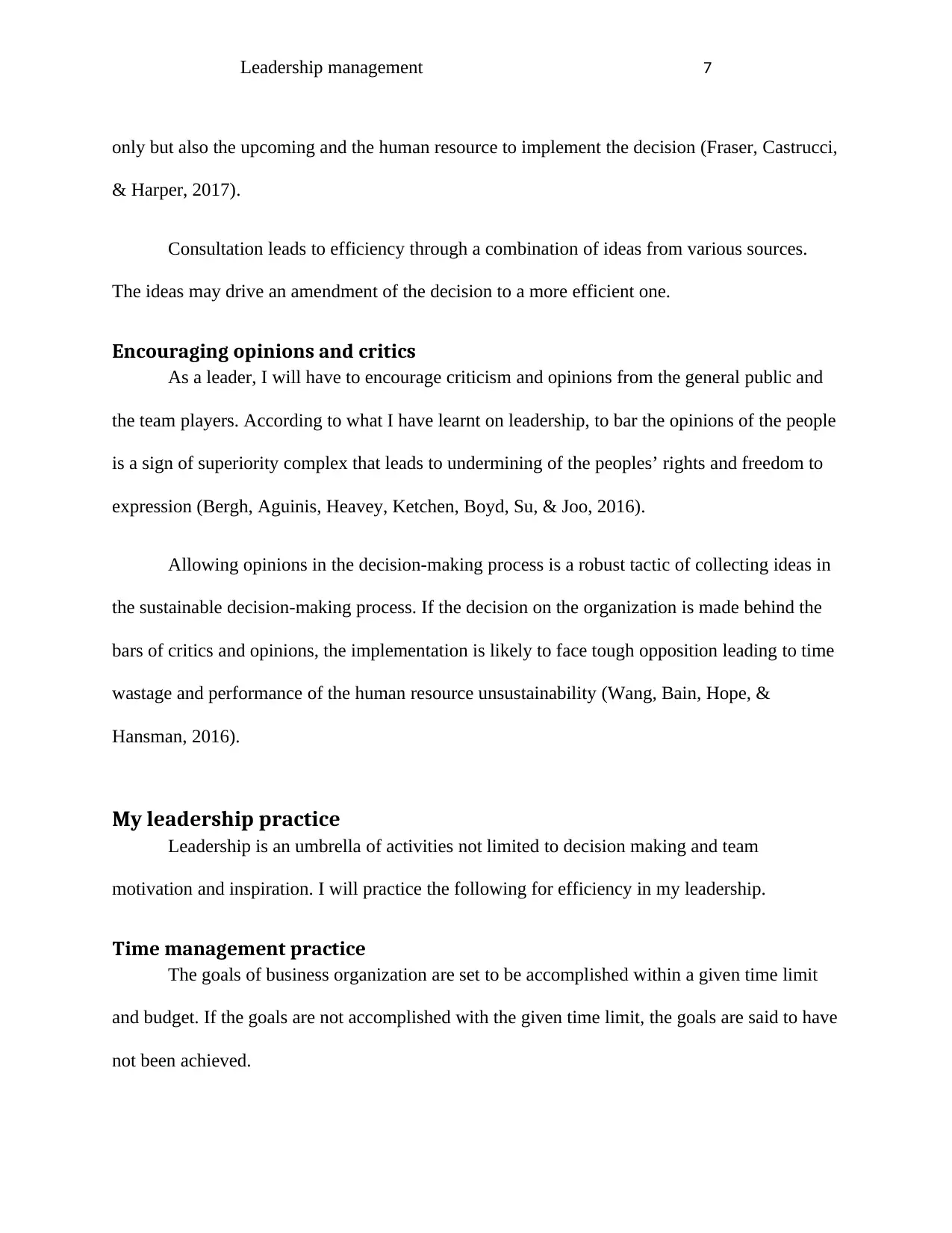
Leadership management 7
only but also the upcoming and the human resource to implement the decision (Fraser, Castrucci,
& Harper, 2017).
Consultation leads to efficiency through a combination of ideas from various sources.
The ideas may drive an amendment of the decision to a more efficient one.
Encouraging opinions and critics
As a leader, I will have to encourage criticism and opinions from the general public and
the team players. According to what I have learnt on leadership, to bar the opinions of the people
is a sign of superiority complex that leads to undermining of the peoples’ rights and freedom to
expression (Bergh, Aguinis, Heavey, Ketchen, Boyd, Su, & Joo, 2016).
Allowing opinions in the decision-making process is a robust tactic of collecting ideas in
the sustainable decision-making process. If the decision on the organization is made behind the
bars of critics and opinions, the implementation is likely to face tough opposition leading to time
wastage and performance of the human resource unsustainability (Wang, Bain, Hope, &
Hansman, 2016).
My leadership practice
Leadership is an umbrella of activities not limited to decision making and team
motivation and inspiration. I will practice the following for efficiency in my leadership.
Time management practice
The goals of business organization are set to be accomplished within a given time limit
and budget. If the goals are not accomplished with the given time limit, the goals are said to have
not been achieved.
only but also the upcoming and the human resource to implement the decision (Fraser, Castrucci,
& Harper, 2017).
Consultation leads to efficiency through a combination of ideas from various sources.
The ideas may drive an amendment of the decision to a more efficient one.
Encouraging opinions and critics
As a leader, I will have to encourage criticism and opinions from the general public and
the team players. According to what I have learnt on leadership, to bar the opinions of the people
is a sign of superiority complex that leads to undermining of the peoples’ rights and freedom to
expression (Bergh, Aguinis, Heavey, Ketchen, Boyd, Su, & Joo, 2016).
Allowing opinions in the decision-making process is a robust tactic of collecting ideas in
the sustainable decision-making process. If the decision on the organization is made behind the
bars of critics and opinions, the implementation is likely to face tough opposition leading to time
wastage and performance of the human resource unsustainability (Wang, Bain, Hope, &
Hansman, 2016).
My leadership practice
Leadership is an umbrella of activities not limited to decision making and team
motivation and inspiration. I will practice the following for efficiency in my leadership.
Time management practice
The goals of business organization are set to be accomplished within a given time limit
and budget. If the goals are not accomplished with the given time limit, the goals are said to have
not been achieved.
Paraphrase This Document
Need a fresh take? Get an instant paraphrase of this document with our AI Paraphraser
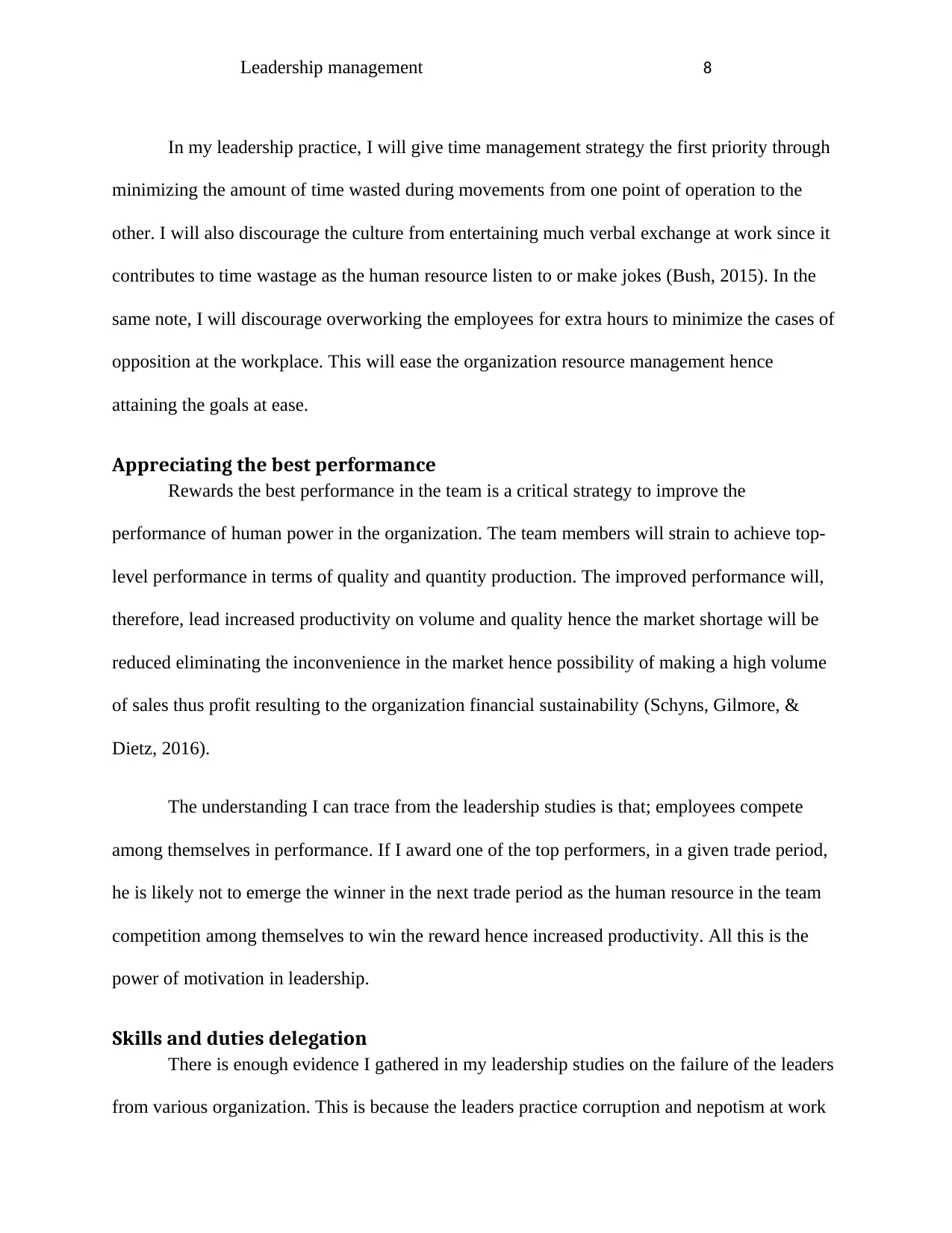
Leadership management 8
In my leadership practice, I will give time management strategy the first priority through
minimizing the amount of time wasted during movements from one point of operation to the
other. I will also discourage the culture from entertaining much verbal exchange at work since it
contributes to time wastage as the human resource listen to or make jokes (Bush, 2015). In the
same note, I will discourage overworking the employees for extra hours to minimize the cases of
opposition at the workplace. This will ease the organization resource management hence
attaining the goals at ease.
Appreciating the best performance
Rewards the best performance in the team is a critical strategy to improve the
performance of human power in the organization. The team members will strain to achieve top-
level performance in terms of quality and quantity production. The improved performance will,
therefore, lead increased productivity on volume and quality hence the market shortage will be
reduced eliminating the inconvenience in the market hence possibility of making a high volume
of sales thus profit resulting to the organization financial sustainability (Schyns, Gilmore, &
Dietz, 2016).
The understanding I can trace from the leadership studies is that; employees compete
among themselves in performance. If I award one of the top performers, in a given trade period,
he is likely not to emerge the winner in the next trade period as the human resource in the team
competition among themselves to win the reward hence increased productivity. All this is the
power of motivation in leadership.
Skills and duties delegation
There is enough evidence I gathered in my leadership studies on the failure of the leaders
from various organization. This is because the leaders practice corruption and nepotism at work
In my leadership practice, I will give time management strategy the first priority through
minimizing the amount of time wasted during movements from one point of operation to the
other. I will also discourage the culture from entertaining much verbal exchange at work since it
contributes to time wastage as the human resource listen to or make jokes (Bush, 2015). In the
same note, I will discourage overworking the employees for extra hours to minimize the cases of
opposition at the workplace. This will ease the organization resource management hence
attaining the goals at ease.
Appreciating the best performance
Rewards the best performance in the team is a critical strategy to improve the
performance of human power in the organization. The team members will strain to achieve top-
level performance in terms of quality and quantity production. The improved performance will,
therefore, lead increased productivity on volume and quality hence the market shortage will be
reduced eliminating the inconvenience in the market hence possibility of making a high volume
of sales thus profit resulting to the organization financial sustainability (Schyns, Gilmore, &
Dietz, 2016).
The understanding I can trace from the leadership studies is that; employees compete
among themselves in performance. If I award one of the top performers, in a given trade period,
he is likely not to emerge the winner in the next trade period as the human resource in the team
competition among themselves to win the reward hence increased productivity. All this is the
power of motivation in leadership.
Skills and duties delegation
There is enough evidence I gathered in my leadership studies on the failure of the leaders
from various organization. This is because the leaders practice corruption and nepotism at work
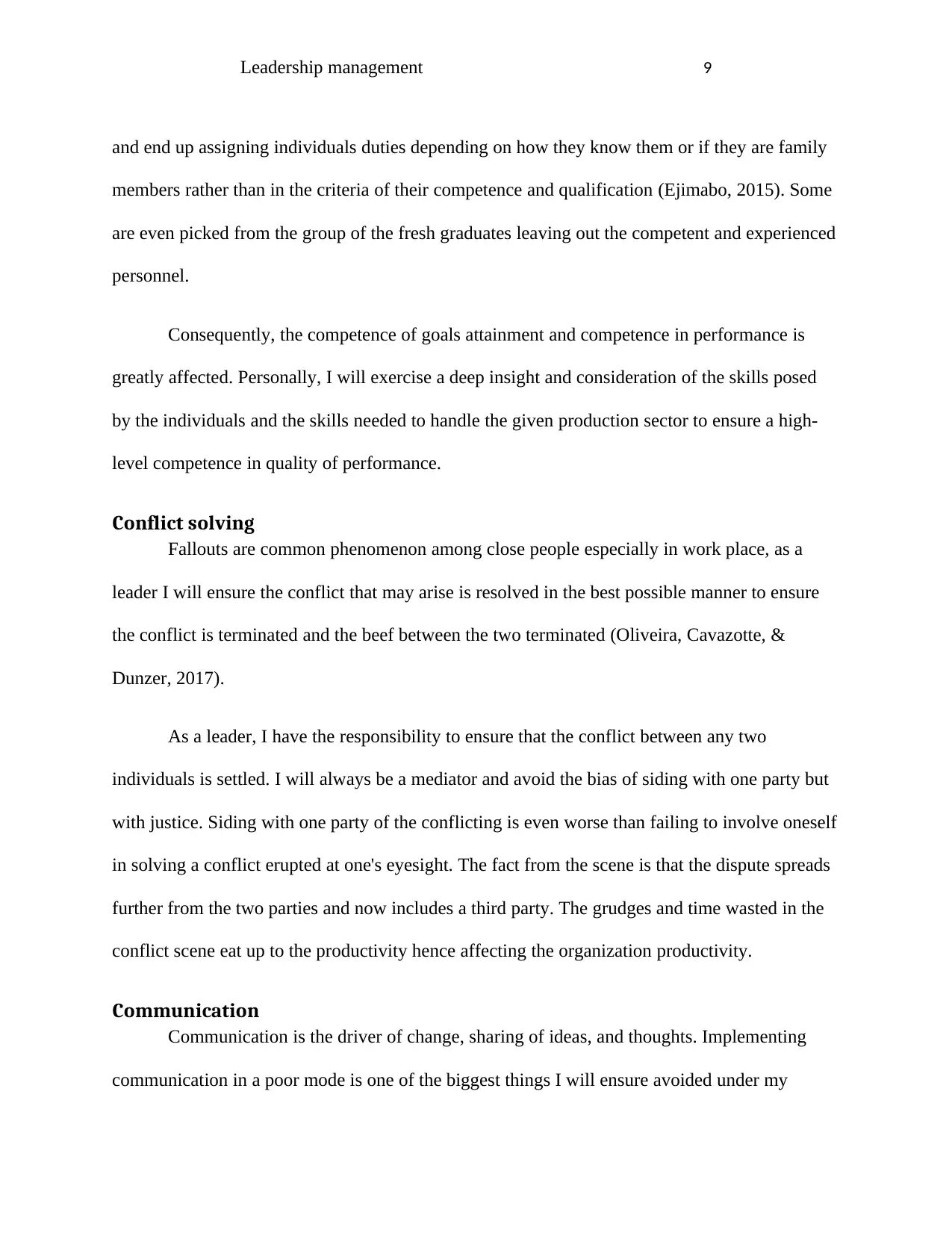
Leadership management 9
and end up assigning individuals duties depending on how they know them or if they are family
members rather than in the criteria of their competence and qualification (Ejimabo, 2015). Some
are even picked from the group of the fresh graduates leaving out the competent and experienced
personnel.
Consequently, the competence of goals attainment and competence in performance is
greatly affected. Personally, I will exercise a deep insight and consideration of the skills posed
by the individuals and the skills needed to handle the given production sector to ensure a high-
level competence in quality of performance.
Conflict solving
Fallouts are common phenomenon among close people especially in work place, as a
leader I will ensure the conflict that may arise is resolved in the best possible manner to ensure
the conflict is terminated and the beef between the two terminated (Oliveira, Cavazotte, &
Dunzer, 2017).
As a leader, I have the responsibility to ensure that the conflict between any two
individuals is settled. I will always be a mediator and avoid the bias of siding with one party but
with justice. Siding with one party of the conflicting is even worse than failing to involve oneself
in solving a conflict erupted at one's eyesight. The fact from the scene is that the dispute spreads
further from the two parties and now includes a third party. The grudges and time wasted in the
conflict scene eat up to the productivity hence affecting the organization productivity.
Communication
Communication is the driver of change, sharing of ideas, and thoughts. Implementing
communication in a poor mode is one of the biggest things I will ensure avoided under my
and end up assigning individuals duties depending on how they know them or if they are family
members rather than in the criteria of their competence and qualification (Ejimabo, 2015). Some
are even picked from the group of the fresh graduates leaving out the competent and experienced
personnel.
Consequently, the competence of goals attainment and competence in performance is
greatly affected. Personally, I will exercise a deep insight and consideration of the skills posed
by the individuals and the skills needed to handle the given production sector to ensure a high-
level competence in quality of performance.
Conflict solving
Fallouts are common phenomenon among close people especially in work place, as a
leader I will ensure the conflict that may arise is resolved in the best possible manner to ensure
the conflict is terminated and the beef between the two terminated (Oliveira, Cavazotte, &
Dunzer, 2017).
As a leader, I have the responsibility to ensure that the conflict between any two
individuals is settled. I will always be a mediator and avoid the bias of siding with one party but
with justice. Siding with one party of the conflicting is even worse than failing to involve oneself
in solving a conflict erupted at one's eyesight. The fact from the scene is that the dispute spreads
further from the two parties and now includes a third party. The grudges and time wasted in the
conflict scene eat up to the productivity hence affecting the organization productivity.
Communication
Communication is the driver of change, sharing of ideas, and thoughts. Implementing
communication in a poor mode is one of the biggest things I will ensure avoided under my
⊘ This is a preview!⊘
Do you want full access?
Subscribe today to unlock all pages.

Trusted by 1+ million students worldwide
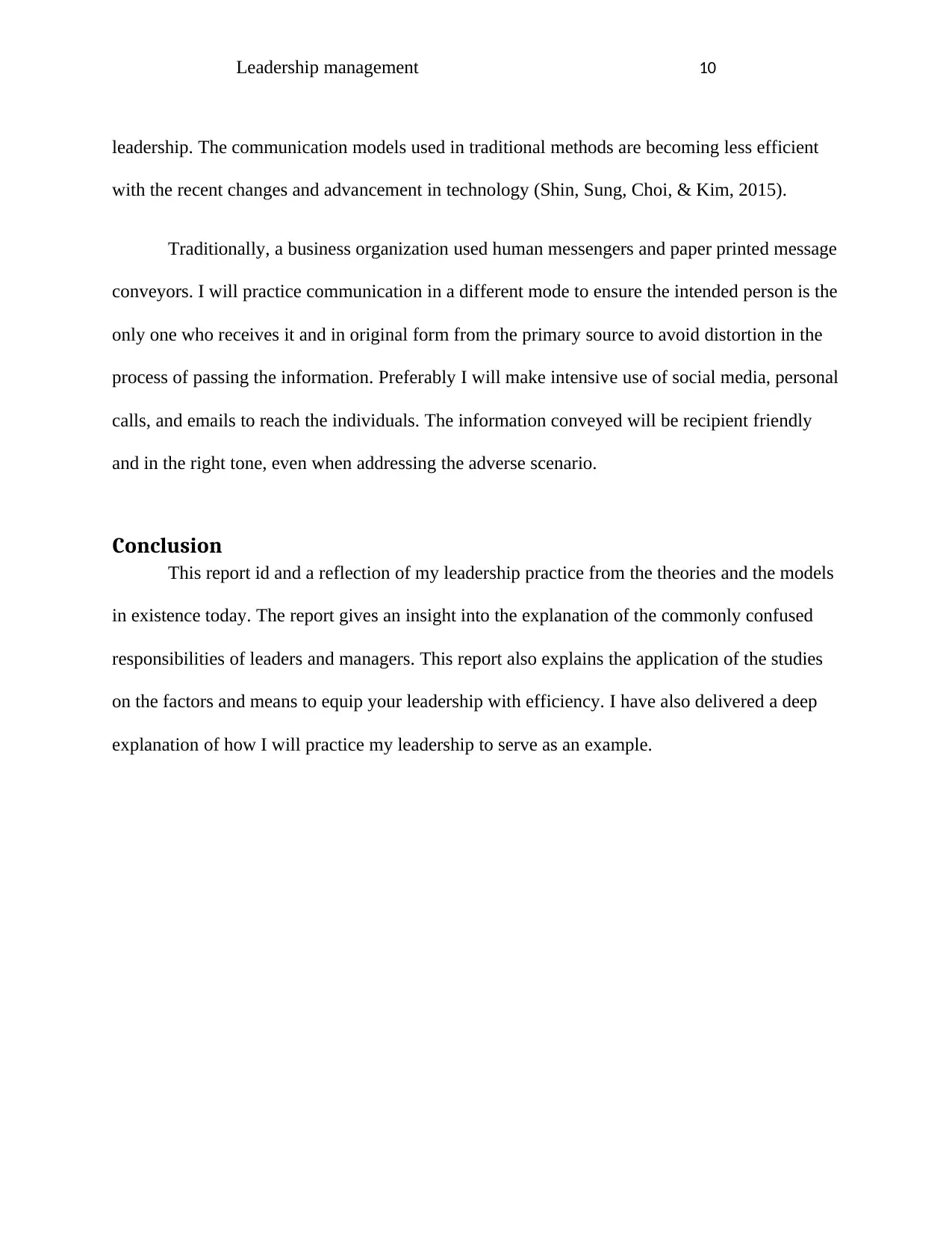
Leadership management 10
leadership. The communication models used in traditional methods are becoming less efficient
with the recent changes and advancement in technology (Shin, Sung, Choi, & Kim, 2015).
Traditionally, a business organization used human messengers and paper printed message
conveyors. I will practice communication in a different mode to ensure the intended person is the
only one who receives it and in original form from the primary source to avoid distortion in the
process of passing the information. Preferably I will make intensive use of social media, personal
calls, and emails to reach the individuals. The information conveyed will be recipient friendly
and in the right tone, even when addressing the adverse scenario.
Conclusion
This report id and a reflection of my leadership practice from the theories and the models
in existence today. The report gives an insight into the explanation of the commonly confused
responsibilities of leaders and managers. This report also explains the application of the studies
on the factors and means to equip your leadership with efficiency. I have also delivered a deep
explanation of how I will practice my leadership to serve as an example.
leadership. The communication models used in traditional methods are becoming less efficient
with the recent changes and advancement in technology (Shin, Sung, Choi, & Kim, 2015).
Traditionally, a business organization used human messengers and paper printed message
conveyors. I will practice communication in a different mode to ensure the intended person is the
only one who receives it and in original form from the primary source to avoid distortion in the
process of passing the information. Preferably I will make intensive use of social media, personal
calls, and emails to reach the individuals. The information conveyed will be recipient friendly
and in the right tone, even when addressing the adverse scenario.
Conclusion
This report id and a reflection of my leadership practice from the theories and the models
in existence today. The report gives an insight into the explanation of the commonly confused
responsibilities of leaders and managers. This report also explains the application of the studies
on the factors and means to equip your leadership with efficiency. I have also delivered a deep
explanation of how I will practice my leadership to serve as an example.
Paraphrase This Document
Need a fresh take? Get an instant paraphrase of this document with our AI Paraphraser
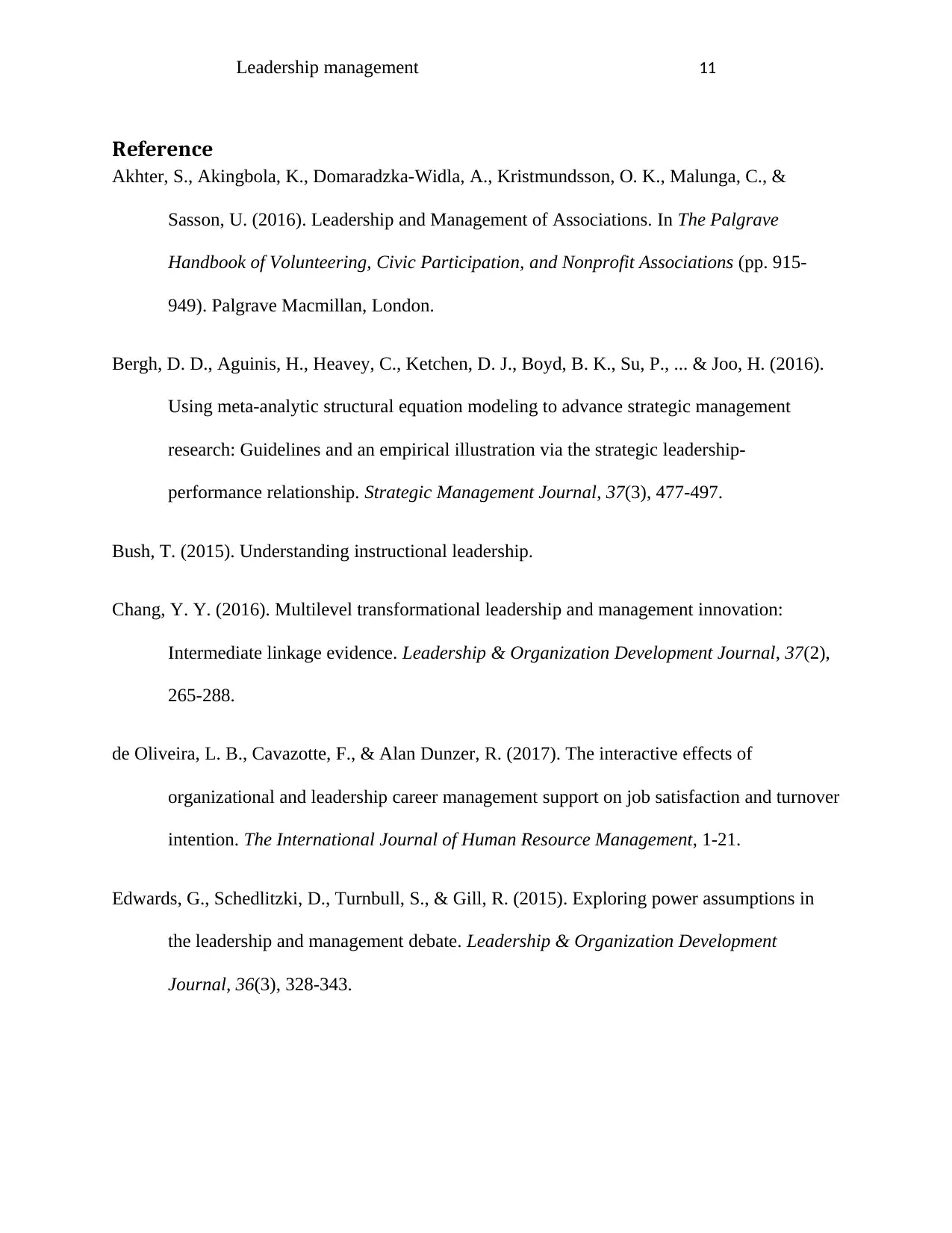
Leadership management 11
Reference
Akhter, S., Akingbola, K., Domaradzka-Widla, A., Kristmundsson, O. K., Malunga, C., &
Sasson, U. (2016). Leadership and Management of Associations. In The Palgrave
Handbook of Volunteering, Civic Participation, and Nonprofit Associations (pp. 915-
949). Palgrave Macmillan, London.
Bergh, D. D., Aguinis, H., Heavey, C., Ketchen, D. J., Boyd, B. K., Su, P., ... & Joo, H. (2016).
Using meta‐analytic structural equation modeling to advance strategic management
research: Guidelines and an empirical illustration via the strategic leadership‐
performance relationship. Strategic Management Journal, 37(3), 477-497.
Bush, T. (2015). Understanding instructional leadership.
Chang, Y. Y. (2016). Multilevel transformational leadership and management innovation:
Intermediate linkage evidence. Leadership & Organization Development Journal, 37(2),
265-288.
de Oliveira, L. B., Cavazotte, F., & Alan Dunzer, R. (2017). The interactive effects of
organizational and leadership career management support on job satisfaction and turnover
intention. The International Journal of Human Resource Management, 1-21.
Edwards, G., Schedlitzki, D., Turnbull, S., & Gill, R. (2015). Exploring power assumptions in
the leadership and management debate. Leadership & Organization Development
Journal, 36(3), 328-343.
Reference
Akhter, S., Akingbola, K., Domaradzka-Widla, A., Kristmundsson, O. K., Malunga, C., &
Sasson, U. (2016). Leadership and Management of Associations. In The Palgrave
Handbook of Volunteering, Civic Participation, and Nonprofit Associations (pp. 915-
949). Palgrave Macmillan, London.
Bergh, D. D., Aguinis, H., Heavey, C., Ketchen, D. J., Boyd, B. K., Su, P., ... & Joo, H. (2016).
Using meta‐analytic structural equation modeling to advance strategic management
research: Guidelines and an empirical illustration via the strategic leadership‐
performance relationship. Strategic Management Journal, 37(3), 477-497.
Bush, T. (2015). Understanding instructional leadership.
Chang, Y. Y. (2016). Multilevel transformational leadership and management innovation:
Intermediate linkage evidence. Leadership & Organization Development Journal, 37(2),
265-288.
de Oliveira, L. B., Cavazotte, F., & Alan Dunzer, R. (2017). The interactive effects of
organizational and leadership career management support on job satisfaction and turnover
intention. The International Journal of Human Resource Management, 1-21.
Edwards, G., Schedlitzki, D., Turnbull, S., & Gill, R. (2015). Exploring power assumptions in
the leadership and management debate. Leadership & Organization Development
Journal, 36(3), 328-343.
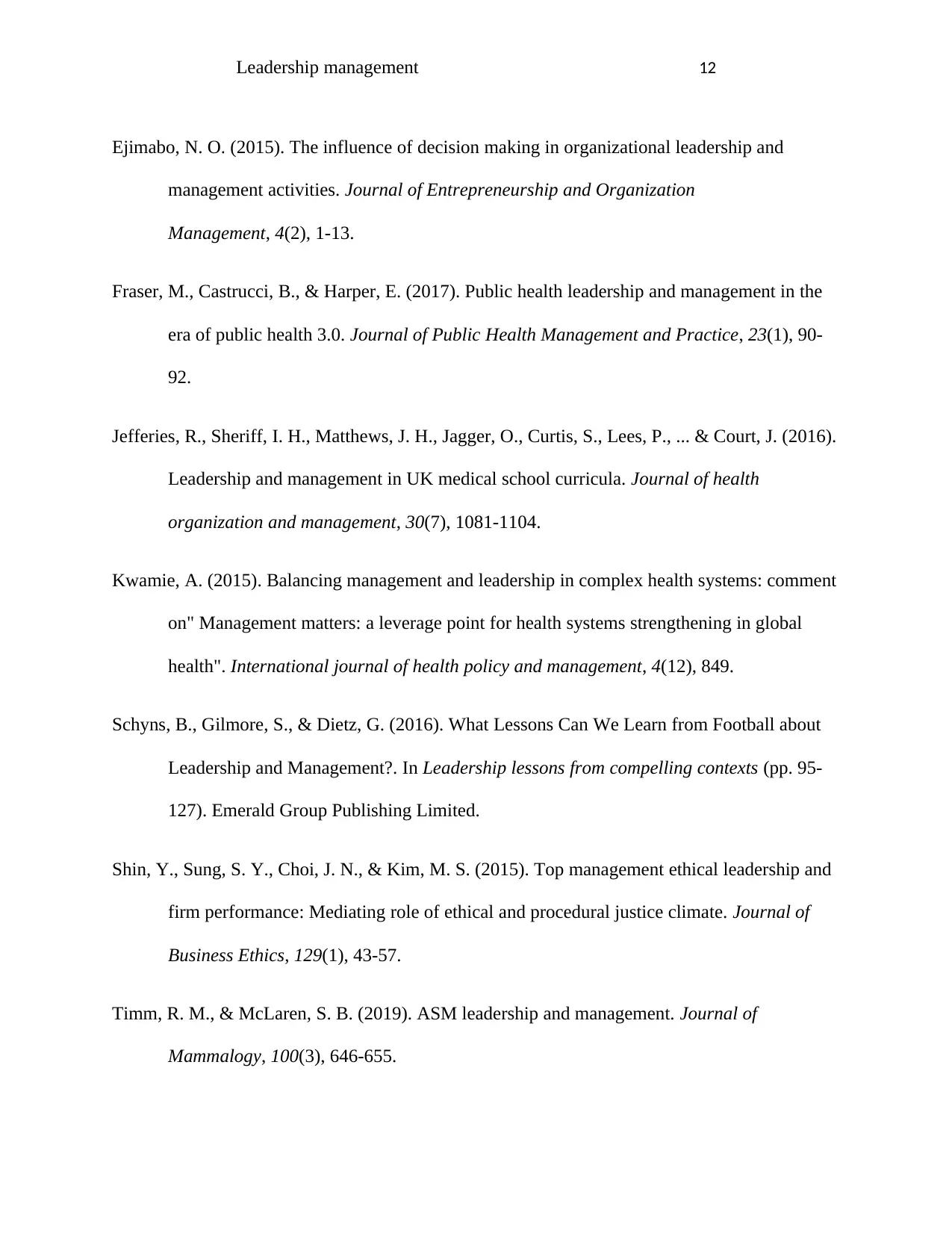
Leadership management 12
Ejimabo, N. O. (2015). The influence of decision making in organizational leadership and
management activities. Journal of Entrepreneurship and Organization
Management, 4(2), 1-13.
Fraser, M., Castrucci, B., & Harper, E. (2017). Public health leadership and management in the
era of public health 3.0. Journal of Public Health Management and Practice, 23(1), 90-
92.
Jefferies, R., Sheriff, I. H., Matthews, J. H., Jagger, O., Curtis, S., Lees, P., ... & Court, J. (2016).
Leadership and management in UK medical school curricula. Journal of health
organization and management, 30(7), 1081-1104.
Kwamie, A. (2015). Balancing management and leadership in complex health systems: comment
on" Management matters: a leverage point for health systems strengthening in global
health". International journal of health policy and management, 4(12), 849.
Schyns, B., Gilmore, S., & Dietz, G. (2016). What Lessons Can We Learn from Football about
Leadership and Management?. In Leadership lessons from compelling contexts (pp. 95-
127). Emerald Group Publishing Limited.
Shin, Y., Sung, S. Y., Choi, J. N., & Kim, M. S. (2015). Top management ethical leadership and
firm performance: Mediating role of ethical and procedural justice climate. Journal of
Business Ethics, 129(1), 43-57.
Timm, R. M., & McLaren, S. B. (2019). ASM leadership and management. Journal of
Mammalogy, 100(3), 646-655.
Ejimabo, N. O. (2015). The influence of decision making in organizational leadership and
management activities. Journal of Entrepreneurship and Organization
Management, 4(2), 1-13.
Fraser, M., Castrucci, B., & Harper, E. (2017). Public health leadership and management in the
era of public health 3.0. Journal of Public Health Management and Practice, 23(1), 90-
92.
Jefferies, R., Sheriff, I. H., Matthews, J. H., Jagger, O., Curtis, S., Lees, P., ... & Court, J. (2016).
Leadership and management in UK medical school curricula. Journal of health
organization and management, 30(7), 1081-1104.
Kwamie, A. (2015). Balancing management and leadership in complex health systems: comment
on" Management matters: a leverage point for health systems strengthening in global
health". International journal of health policy and management, 4(12), 849.
Schyns, B., Gilmore, S., & Dietz, G. (2016). What Lessons Can We Learn from Football about
Leadership and Management?. In Leadership lessons from compelling contexts (pp. 95-
127). Emerald Group Publishing Limited.
Shin, Y., Sung, S. Y., Choi, J. N., & Kim, M. S. (2015). Top management ethical leadership and
firm performance: Mediating role of ethical and procedural justice climate. Journal of
Business Ethics, 129(1), 43-57.
Timm, R. M., & McLaren, S. B. (2019). ASM leadership and management. Journal of
Mammalogy, 100(3), 646-655.
⊘ This is a preview!⊘
Do you want full access?
Subscribe today to unlock all pages.

Trusted by 1+ million students worldwide
1 out of 13
Related Documents
Your All-in-One AI-Powered Toolkit for Academic Success.
+13062052269
info@desklib.com
Available 24*7 on WhatsApp / Email
![[object Object]](/_next/static/media/star-bottom.7253800d.svg)
Unlock your academic potential
Copyright © 2020–2025 A2Z Services. All Rights Reserved. Developed and managed by ZUCOL.





